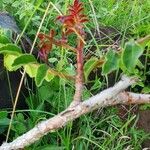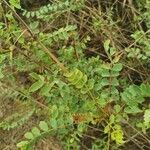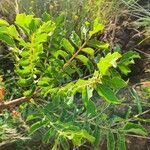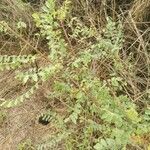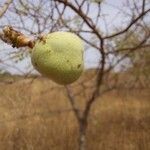A spreading deciduous tree up to 18 m. high; bole pale grey, widely reticulate and flaking in small or large scales.. Leaves variable, 7–37-foliolate, 10–38 cm. long; rachis semicylindric, grooved above, glabrous; leaflets round, ovate, obovate, elliptic or oblong-elliptic, 0.8–9(–11) cm. long, 0.7–3.5(6) cm. broad, acuminate or cuspidate to obtuse or apiculate at the apex, asymmetric and slightly cuneate or rounded at the base, margin entire to dentate-serrate (especially on new outgrowths), lateral ones sessile or with petiolules up to 3 cm. long, the terminal petiolule up to 5 cm. long, membranous to semicoriaceous, glabrous; midrib prominent beneath; lateral nerves distinct on both sides and impressed or slightly raised and reticulate beneath.. Male inflorescences 7–22 cm. long; peduncle puberulous; bracts ovate, ± 2 mm. long by 1.5 mm. broad, obtuse, puberulous or glabrous. Male flowers: sepals ± 2 mm. long and broad; petals oblong-ovate, 4–6 mm. long, 3–4 mm. broad, obtuse, yellow to dark red with cream margins; filaments ± 3 mm. long; anthers 1–1.5 mm. long.. Female inflorescences shorter, usually 1 or 2(–3)-flowered; peduncle and pedicels thickened during fruiting stage; sepals and petals similar to ♂; staminodes present; ovary subglobose.. Drupe obovoid, 3–3.5 cm. in diameter, yellow and with a very juicy mesocarp; stone obovoid, 2–3 cm. long, 2.5 cm. in diameter.. Seed 1.5–2 cm. long, 0.4–0.8 cm. wide.
More
A shrub or tree. It grows 9 m high and spreads 6 m wide. It can be 15 m tall. It loses its leaves during the year. The crown is dense and rounded. The bark is grey and finely cracked. The leaves have leaflets along the stalk. The leaves are near the tips of the branches. The edges of the leaflets can be wavy. Plants are separately male and female. Female flowers are reddish and on long stalks at the ends of branches. The fruit are oval or round and 3-4 cm long. They are green but turn yellow as they ripen. The skin is tough and leathery. The pulp is juicy and white. There is one large stone. There are some subspecies.
Sterile regrowth shoots often with coarsely serrate leaflets
Fruits yellow, thick-skinned, resembling a small mango
Flowers greenish-white or reddish
A savannah tree, to 40 ft. high,
A tropical plant. It grows in the lowlands. It grows in equatorial Africa. It grows in dry areas. It grows in the Sahel. It can grow in arid places. It grows in Miombo woodland in Africa. In Brisbane Botanical Garden. In Ethiopia it grows between 500-1,700 m above sea level.
More
Drier savannah of the Sahel. Wooded grasslands, riverine woodlands and bushlands. Mixed deciduous woodland and wooded grassland, often on rocky hills, from sea level to 1,200 metres.
In the drier savannah regions.
Plants can be grown by seeds but the seeds do not easily germinate. They need to have a hole cut in the hard seed coat or put into sulphuric acid. The seeds can be soaked over night in water before planting. It can be grown from cuttings and root suckers. Using fertilizer, manure and early irrigation reduce the survival and growth of young plants. They are adapted to low fertility and seasonal rainfall.
